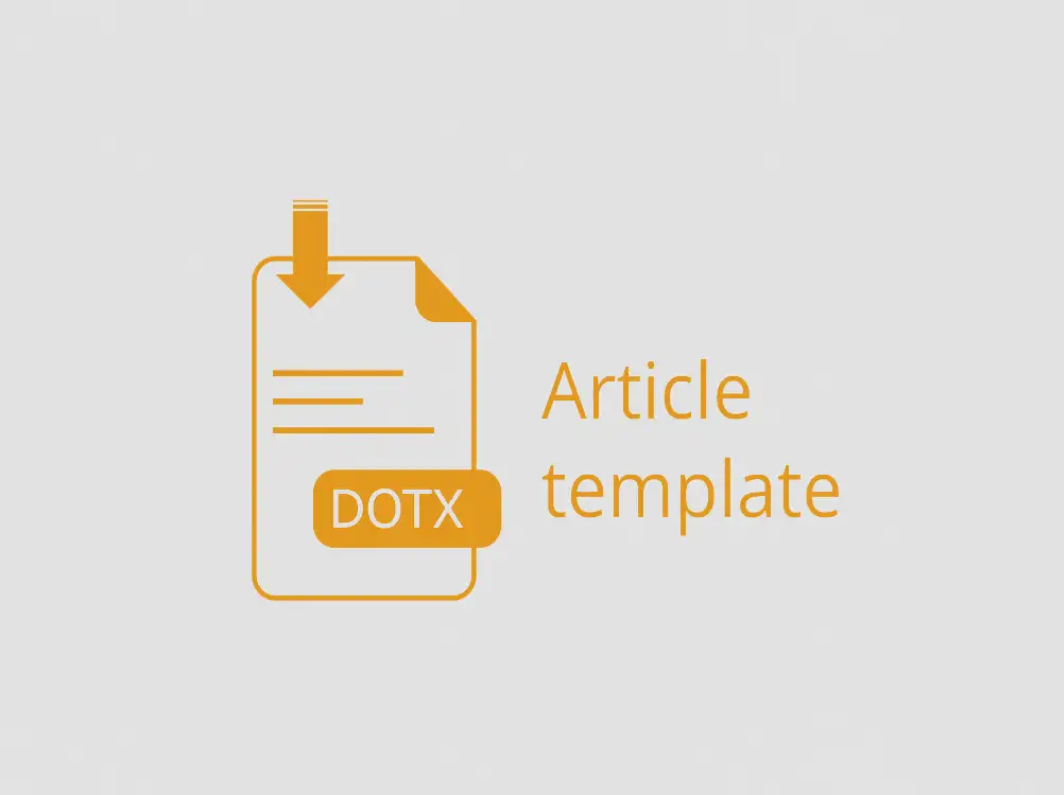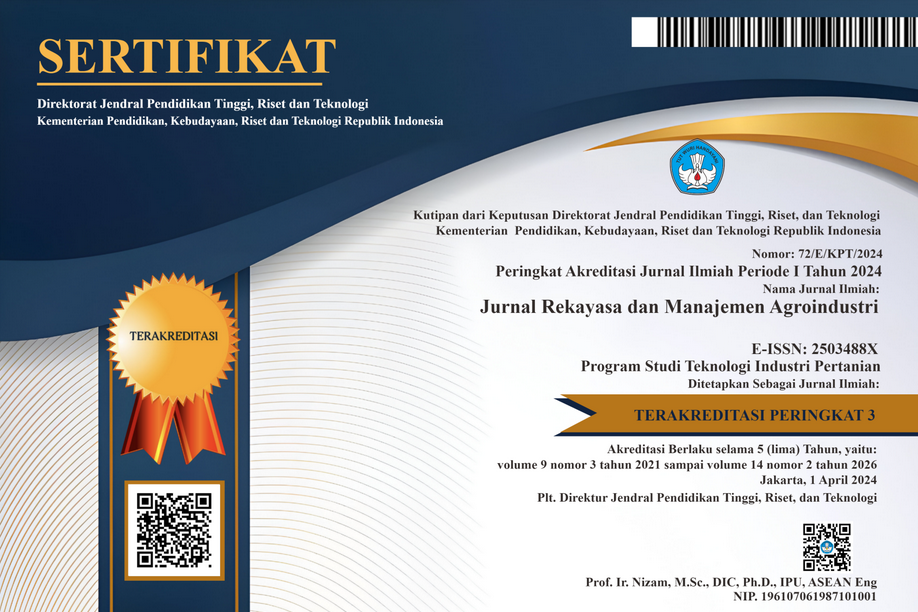Karakteristik Mikroemulsi Minyak Atsiri Kulit Buah Lemon (Citrus limon) Pada Penambahan Kosurfaktan Dan Rasio Surfaktan-Kosurfaktan Dengan Minyak Atsirinya
Abstract
ABSTRACT
Essential oil from lemon peel (Citrus limon) has a distinctive aroma that can be used as a body mist. Body mist is a type of perfume with an essential oil content of 3-5%. Lemon peel essential oil microemulsion is a water-based body mist product. Lemon essential oil microemulsion is formed from a mixture of surfactants (Tween 20, Tween 80 and Span 80), co-surfactant, Polyethylene Glycol (PEG) 400, lemon essential oil and water. The first stage of the research was the formation of fruit peel essential oil microemulsions by treating the mixture ratio of surfactant and co-surfactant. The second stage of the research was the formation of fruit peel essential oil microemulsions by treating the ratio of a mixture of surfactant-cosurfactant and lemon peel essential oil. The results of the first stage showed that the microemulsion of lemon peel essential oil with a mixture ratio of surfactant and PEG 400 (50:50) had a turbidity index value of 0.092%, transmittance of 91.6%, was non-sticky, transparent and stable against centrifugation. The results of the first stage are used in the second stage, namely the mixture ratio of surfactant and Polyethylene Glycol (PEG) 400 (50:50). The results of the second stage, namely the ratio of the mixture of surfactant-PEG 400 and lemon peel essential oil (80:20), showed that the concentration of lemon peel essential oil was the highest which still formed a microemulsion of lemon peel essential oil. This lemon peel essential oil microemulsion has a turbidity index value of 0.089%, transmittance of 91.23%, transparent appearance, stable to centrifugation, stable to pH (4.5; 5.5; 6.5), stable to dilution (1: 9; 1:49; 1:99), stable during 4 weeks of storage, has an average particle size of 32.2 nm and a polydispersion index (PI) value below 0.5.
Keywords : Microemulsion, ratio, surfactant, co-surfactant, citrus limon
ABSTRAK
Minyak atsiri dari kulit buah lemon (Citrus limon) mempunyai aroma khas yang dapat digunakan sebagai body mist. Body mist merupakan salah satu jenis parfum dengan kandungan minyak atsiri sebesar 3-5%. Mikroemulsi minyak atsiri kulit buah lemon merupakan salah satu produk body mist yang berbasis air. Mikroemulsi minyak atsiri buah lemon terbentuk dari campuran surfaktan (Tween 20, Tween 80 dan Span 80), ko-surfaktan, Polieteline glikol (PEG) 400, minyak atsiri buah lemon dan air. Tahap pertama penelitian adalah pembentukan mikroemulsi minyak atsiri kulit buah dengan perlakuan rasio campuran surfaktan dan ko-surfaktan. Tahap kedua penelitian adalah pembentukan mikroemulsi minyak atsiri kulit buah dengan perlakuan rasio campuran surfaktan-kosurfaktan dan minyak atsiri kulit buah lemon. Hasil tahap pertama menunjukkan bahwa mikroemulsi minyak atsiri kulit buah lemon dengan rasio campuran surfaktan dan Polietilen Glikol (PEG) 400 (50:50) mempunyai nilai indeks turbiditas 0,092%, transmisi 91,6%, tidak lengket, transparan dan stabil terhadap sentrifugasi. Hasil tahap pertama digunakan pada tahap kedua yaitu rasio campuran surfaktan dan PEG 400 (50:50). Hasil tahap kedua yaitu rasio campuran surfaktan-PEG 400 dan minyak atsiri kulit buah lemon (80:20) menunjukkan bahwa konsentrasi minyak atsiri kulit buah lemon tertinggi yang masih membentuk mikroemulsi minyak atsiri kulit buah lemon. mikroemulsi minyak atsiri kulit buah lemon ini mempunyai nilai indeks turbiditas 0,089%, transmisi 91,23%, kenampakan transparan, stabil terhadap sentrifugasi, stabil terhadap pH (4,5; 5,5; 6,5), stabil terhadap pengenceran (1:9; 1:49; 1:99), stabil selama penyimpanan 4 minggu, mempunyai ukuran partikel rata-rata 32,2 nm dan nilai polidispersi indeks (PI) di bawah 0,5.
Kata kunci : Mikroemulsi rasio, surfaktan, ko-surfaktan, citrus limon
Downloads
References
Chandra, A., Sharma, P. K., and Irchhiaya, R. 2009. Microemulsion-based hydrogel formulation for transdermal delivery of dexamethasone. Asian Journal of Pharmaceutics, 3(1), 30–36.
Draelos, Z. D., and Thaman, L. A. 1996. Cosmetic formulation of skin care. New York: Taylor and Francis. https://doi.org/https://doi.org/10.3109/9781420020854
El-Laithy, H. M. 2003. Preparation and physicochemical characteristic of dioctyl sodium sulfosuccinate (aerosol OT) microemulsion for oral drug delivery. AAPS Pharmscitech, 4(1), 80–89.
Filasavita, P. I., Rubiyanto, D., dan Julianto, T. S. 2014. Analisis senyawa berbehaya dalam parfum dengan kromatografi gas-spektrometri massa berdasarkan material safety data sheet (MSDS). Journal of Chemical Research, 2(1), 18–27.
Hyldgaard, M., Mygind, T., and Meyer, R. L. 2012. Essential oils in food preservation: mode of action synergies, and interactions with food matrix components. Frontiers in Microbiology, 3(12).
Jain, S., and Nagori, B. P. 2015. Utility of in-silico investigation and systematic selection of components for the development of diacerein microemulsion. Pelagia Research Library Der Pharmacia Sinica, 6(12), 39–47.
Jidong, S. 2007. D-limonenen: safety and clinical applications. Alternative Medicine Review. https://pubmed.ncbi.nlm.nih.gov/18072821/
Mc Clements, D. J., Decker, E. A., and Weiss, J. 2007. Emulsion-based delevery systems for lipophillic bioactive components. J. FoodScience, 72(8), R109–R112. https://doi.org/https://doi.org/10.1111/j.1750-3841.2007.00507
Meidina, S. N., Muzakki, M. R., Nadya, S. A., Naufal, S. M., dan Rana, R. N. (2015). Makalah teknologi ditilasi parfum. Universitas Indonesia.
Nakatsu, T., Andre, T., Lupo, J., John, W., Chinn, J., and Kang, R. K. L. 2000. Biological activity of essential oils and their constituents. Studies in Natural Product Chemistry. Bioactive Natural Products (Part B), 21(571–631). https://doi.org/https://doi.org/10.1016/S1572-5995(00)80014-9.
Nurmalasari, L., Suhendra, L., and Harsojuwono, B. A. 2023. Microemultion synthesis using surfactants and sweet orange peel essential oil (Citrus sinensis) as body mist. Jurnal Rekayasa Dan Manajemen Agroindustri, 11(1), 14–24.
Priani, S. E., Dewi, W. K., dan Gadri, A. 2019. Formulasi sediaan mikroemulsi gel anti jerawat mengandung kombinasi minyak jinten hitam (Nigella sativa L.) dan minyak zaitun (Olea europaea L.). Kartika : Jurnal Ilmiah Farmasi, 6(2), 57. https://doi.org/10.26874/kjif.v6i2.143
Purnojati, P., Patil, R. T., Sheth, P. D., Bommared, G., Dondeti, P., and Egbaria, K. 2007. Design and development of topical microelmulsion for poorly water soluble antifungal agents. The Journal of Applied Research In Clinical and Experimental Therapeutics. http://www.jarcet.com/articles/Vol2Iss1/puranajoti.htm
Rahmawanty, D., A. Effionora., dan A. Bahtiar. 2014. Rasio gel menggunakan serbuk daging ikan haruan (Channa striatus) sebagai penyembuh luka. Media Farmasi: Jurnal Ilmu Farmasi, 11(1)
Rosano HL, and Clausse M. 1985. Microemulsion System
Rismarika, Indri, M., dan Yusnelti. 2020. Pengaruh konsentrasi PEG 400 sebagai kosurfaktan pada formulasi nanoemulsi minyak kepayang. Chempublish Journal, 5(1), 1–14.
Rowe, R. C., Heskey, S. J., and Quinn, M. . E. 2009. Hanbook of pharmaceutical excipients (6th ed.). Pharmaceutical Press.
Shabrina, A., Pratiwi, A. R., dan Murrukmihadi, M. 2020. Stabilitas Fisik dan Antioksidan Mikroemulsi Minyak Nilam dengan Variasi Tween 80 dan PEG 400. Media Farmasi, 16(2), 185–192.
Suciati, T., Suhendra, L., dan Harsojuwono, B. A. 2023. Sintesis mikroemulsi menggunakan surfaktan dan minyak atsiri kulit buah lemon (Citrus limon) sebagai face mist. 11(1), 92–103.
Suhendra, L., Raharjo, S., Hastuti, O., dan Hidayat, C. 2012. Formulasi dan stabilitas mikroemulsi m/a sebagai pembawa fucoxanthin. Agritech, 32(3), 230–239. https://doi.org/Doi: https://doi.org/10.22146/agritech.9617
Suryafly, F. D., dan Aziz, R. R. 2019. Enkapsulasi minyak atsiri lemon (Citrus limon) menggunakan penyalut b-siklodekstrin terasetilasi (sebuah review). Fakultas Sains Dan Teknologi, UIN Alauddin Makassar, Sulawesi Selatan.

Ciptaan disebarluaskan di bawah Lisensi Creative Commons Atribusi-BerbagiSerupa 4.0 Internasional.
Seluruh artikel di Jurnal ini dapat disebarluaskan atas tetap mencantumkan sumber yang syah. Identitas judul artikel tidak boleh dihilangkan. Penerbit tidak bertangggung jawab terhadap naskah yang dipublikasikan. Isi artikel menjadi tanggung jawab Penulis.














